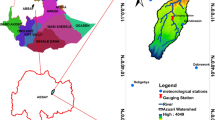Abstract
Wular Lake, one of the largest freshwater lakes of Jhelum River Basin, is showing signs of deterioration due to the anthropogenic impact and changes in the land use/land cover (LULC) and hydrometeorological climate of the region. The present study investigated the impacts of temporal changes in LULC and meteorological and hydrological parameters to evaluate the current status of Wular Lake environs using multisensor, multitemporal satellite and observatory data. Satellite images acquired for the years 1992, 2001, 2005, and 2008 were used for determining changes in the LULC in a buffer area of 5 km2 around the Wular Lake. LULC mapping and change analysis using the visual interpretation technique indicated significant changes around the Wular Lake during the last two decades. Reduction in lake area from 24 km2 in 1992 to 9 km2 in 2008 (−62.5 %) affected marshy lands, the habitat of migratory birds, which also exhibited drastic reduction from 85 km2 in 1992 to 5 km2 in 2008 (−94.117 %). Marked development of settlements (642.85 %) in the peripheral area of the Wular Lake adversely affected its varied aquatic flora and fauna. Change in climatic conditions, to a certain extent, is also responsible for the decrease in water level and water spread of the lake as witnessed by decreased discharge in major tributaries (Erin and Madhumati) draining into the Wular Lake.










Similar content being viewed by others
References
Badar B, Romshoo SA (2007) Assessing the pollution load of Dal Lake using geospatial tools. In: Proc. of TAAL 2007: the 12th World Lake Conference, pp 668–679
Badar B, Romshoo SA, Khan MA (2013) Intergrating biophysical and socioeconomic information for prioritizing watersheds in a Kashmir Himalayan lake: a remote sensing and GIS approach. Environmental Monitoring Assessment 185:6419–6445
Badreldin N, Gossens R (2013) Monitoring land use/land cover change using multi-temporal Landsat satellite images in an arid environment: a case study of El-Arish, Egypt. Arab J Geosci. doi:10.1007/s12517-013-0916-3
Ballatore TJ, Muhandiki VS (2002) The case for a world lake vision. Hydrol Process 16(11):2079–2089
Dar NA, Hamid A, Pandit AK, Ganai BA, Bhat SU, Hussain A (2013) Total lipid content in macrophytes of Wular Lake, a Ramsar site in Kashmir Himalaya. Int J Plant Physiol Biochem 5(1):11–15
Fohrer N, Haverkamp S, Eckhardt K, Frede GG (2001) Hydrologic response to land use changes on the catchment scale. Phys Chem Earth 26(7–8):577–582
International Lake Environment Committee (ILEC) (2005) Managing lakes and their basins for sustainable use: a report for lake basin managers and stakeholders. International Lake Environment Committee Foundation, Kusatsu
Kaul V (1979) Water characteristics of some fresh water bodies of Kashmir. Curr Trends Life Sci 9:221–246
Khan MA (2008) Chemical environment and nutrient fluxes in a flood plain wetland ecosystem, Kashmir Himalayas, India. Indian Forester 134(4):505–514
Khan MA (2010) Environmental contamination of Hokersar wetland waters in Kashmir Himalayan Valley. J Environ Sci Eng 52(2):157–162
Lesschen JP, Verburg PH, Staal SJ (2005) Statistical methods for analysing the spatial dimension of changes in land use and farming systems. LUCC Report Series 7. The International Livestock Research Institute, Nairobi, Kenya and LUCC Focus 3 Office, Wageningen University, The Netherlands
Li XY, Ma YJ, Xu HY, Wang JH, Zhang DS (2009) Impact of land use and land cover change on environmental degradation in lake Qinghai watershed, Northeast Qinghai–Tibet Plateau. Land Degrad Dev 20:69–83
Masoodi A, Khan FA (2012) Invasion of alligator weed (Alternanthera philoxeroides) in Wular Lake, Kashmir. Proc. of the 17th International Conference on Aquatic Invasive Species, India. Aquat Invasions 7(1):143–146
Matheussen B, Kirschbaum RL, Goodman IA, O'Donnell GM, Lettenmaier DP (2000) Effects of land use change on stream flow in the interior Columbia River Basin (USA and Canada). Hydrol Process 14(5):867–885
Othman AA, Al-Saady YI, Al- Khafaji AK, Gloaguen K (2013) Environmental change detection in the central part of Iraq using remote sensing and GIS. Arab J Geosci. doi:10.1007/s12517-013-0870-0
Pandit AK (1998) Trophic evolution of lakes in Kashmir Himalayas: conservation of lakes in Kashmir Himalayas. In: Pandit AK (ed) Natural resources in Kashmir Himalayas. Valley Book House, Srinagar, pp 178–214
Pandit AK, Qadri SS (1990) Floods threatening Kashmir wetlands. J Environ Manage 3(4):299–311
Quilbe R, Rousseau AN, Moquet JS, Savary S, Ricard S, Garbouj MS (2008) Hydrological response of a watershed to historical land use evolution and future land use scenario under climate change conditions. Hydrol Earth Syst Sci 12:101–110
Romshoo SA, Rashid I (2012) Assessing the impacts of changing land cover and climate on Hokesar wetland in Indian Himalayas. Arab J Geosci. doi:10.1007/s12517-012-0761-9
Shah SA, Bhat GA (2004) Land use pattern in Dal–Dachigam Catchment. J Res Dev 4:21–33
Shah JA, Pandit AK (2012) Physico-chemical characteristics of water in Wular Lake—a Ramsar site in Kashmir Himalaya. International Journal of Geology, Earth and Environmental Sciences, pp 257–265
Wetlands International (2007) The comprehensive management action plan on Wular Lake, Kashmir. Wetlands International-South Asia Final Report, New Delhi, India, 221 pp
Author information
Authors and Affiliations
Corresponding author
Rights and permissions
About this article
Cite this article
Mushtaq, F., Pandey, A.C. Assessment of land use/land cover dynamics vis-à-vis hydrometeorological variability in Wular Lake environs Kashmir Valley, India using multitemporal satellite data. Arab J Geosci 7, 4707–4715 (2014). https://doi.org/10.1007/s12517-013-1092-1
Received:
Accepted:
Published:
Issue Date:
DOI: https://doi.org/10.1007/s12517-013-1092-1




